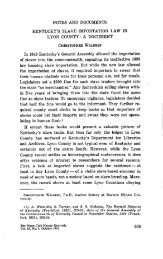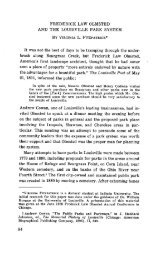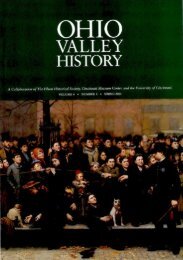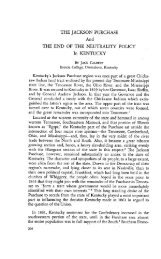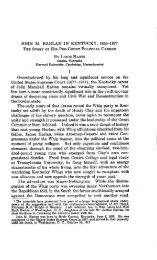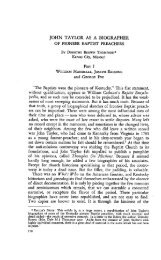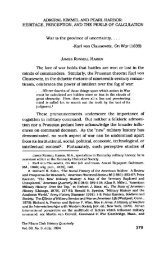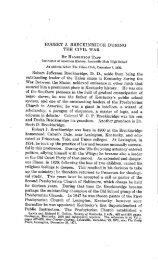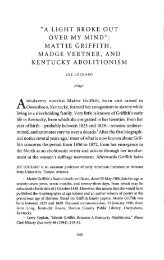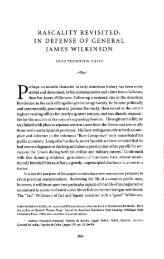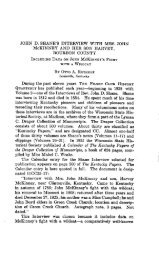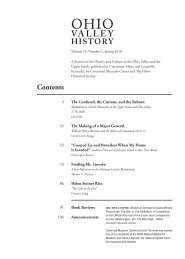Eskippakithiki, The Last Indian Town in Kentucky - The Filson ...
Eskippakithiki, The Last Indian Town in Kentucky - The Filson ...
Eskippakithiki, The Last Indian Town in Kentucky - The Filson ...
Create successful ePaper yourself
Turn your PDF publications into a flip-book with our unique Google optimized e-Paper software.
Vol. 6 ] <strong>The</strong> <strong>Filson</strong> Club History Quarterly 381<br />
<strong>The</strong> Shawnee name <strong>Eskippakithiki</strong> be<strong>in</strong>g all but impossible to<br />
Anglo-Saxon tongues, was early forgotten, but "<strong>Kentucky</strong>," the<br />
Iroquoian name for the same place, be<strong>in</strong>g delightfully easy to pronounce,<br />
has lived on as the name of our State.<br />
i <strong>Eskippakithiki</strong> is called the last <strong>Indian</strong> town <strong>in</strong> <strong>Kentucky</strong> with a full realization<br />
that dur<strong>in</strong>g the whole life of the Lower Shawnee <strong>Town</strong> on the north bank of the<br />
Ohio, at the mouth of the Seioto there were cab<strong>in</strong>s w th their <strong>Indian</strong> residents<br />
upon the opposite south bank of t e Ohio. Christopher Gist built a cab<strong>in</strong> on the<br />
south side <strong>in</strong> 1751; and a trad<strong>in</strong>g company consist<strong>in</strong>g of Colonel George Croghan<br />
William Trent, Robert Calendar, and Michael Teaft had a store there <strong>in</strong> 1754, at the<br />
time the French and <strong>Indian</strong> outbreak drove the English traders out of the Ohio<br />
Valle r, but these cab<strong>in</strong>s.never constituted an organized town; they were but an<br />
outly<strong>in</strong>g part of the town on the north bank of the Ohio, where their residents<br />
exercised their rights of citizenship. It would be impossible to separate thehistory<br />
of the few <strong>Kentucky</strong> cab<strong>in</strong>s on the south bank from the history of the ma<strong>in</strong><br />
Lower Shawnee <strong>Town</strong> opposite them on the north shore of the Ohio.<br />
2 In the course of their troubled history the Shawnees were driven at various<br />
times by Iroquois, Miamis, Catawbas, Chickasaws, Cherokees, Natchez, South<br />
Carol<strong>in</strong>ians, Pennsylvanians, Virg<strong>in</strong>ians, the British government, Kentuckians, and<br />
the United States forces; and they have fled for protection to the Siouans. Yuchis,<br />
French, Chickasaws, Cherokees Creeks Spanl sh, South Carol<strong>in</strong>ians, Natchez<br />
Mohicans, New Yorkers, Delawares Pennsylvanians, Six Nations, and the British<br />
<strong>in</strong> Canada, yet at the close of their active career they were our most valiant <strong>Indian</strong><br />
foes.<br />
s Franquel<strong>in</strong>'s map of 1688. See Narrative and Critical History of America, Just<strong>in</strong><br />
W<strong>in</strong>sor, Vol. IV, pp. 230-231.<br />
4 On November 12, 1755, Colonel George Croghan wrote James Hamilton, "the<br />
Six Nations, while they stand neuter . . . have already settled some of the Upper<br />
Cherokees on <strong>Kentucky</strong>, a creek near the Lower Shawnee <strong>Town</strong>." This reference is<br />
mystify<strong>in</strong>g. It is possible that, when the Shawnees left <strong>Kentucky</strong>, the Six Nations<br />
<strong>in</strong>duced some Overhill Cherokees to move <strong>in</strong>to <strong>Kentucky</strong>, possibly <strong>in</strong>to the deserted<br />
houses and abandoned cornfields of the Shawnees at our village, thus hold<strong>in</strong>g the<br />
land aga<strong>in</strong>st the French, whose dom<strong>in</strong>ion the Six Nations did not wish extended, but<br />
noth<strong>in</strong>g else about this is def<strong>in</strong>itely known. Possibly it was a Six Nations' tale to<br />
please .the British• Possibly, also, Colonel Croghan was mistaken, as about this<br />
time he wrote another letter <strong>in</strong> which he mentions the Hoiston as a head stream of<br />
the <strong>Kentucky</strong> River a mistake that can be seen <strong>in</strong> nearly all of the early maps, and<br />
the settlement mentioned by him may have been merely one of the Hoiston Cherokee<br />
towns. In their sale to the Transylvania Company the Cherokees made no claim<br />
to any country north of the <strong>Kentucky</strong> River.<br />
* See Ludwell Papers <strong>in</strong> the archives of the Virg<strong>in</strong>ia Historical Society published<br />
by D. I. Bushnell, Jr., <strong>in</strong> American Anthropologist, new seriesj Vol. X No. 4 pp.<br />
568 574.<br />
7 Catahecassa was one of the greatest leaders the Shawnees produced dur<strong>in</strong>g the<br />
period of their greatest activity. He was present at Braddoek's defeat, <strong>in</strong> 1755j<br />
where he says he shot at Wash<strong>in</strong>gton many times, but, be<strong>in</strong>g unable to hit him, decided<br />
that he bore a charmed life. He was at Po<strong>in</strong>t Pleasant <strong>in</strong> 1774, as a prom<strong>in</strong>ent<br />
officer on the <strong>Indian</strong> side. He was one of the head chiefs at Harmar's andSt. C air s<br />
defeats and at Wayne's victory. After this last he ceased to struggle aga<strong>in</strong>st the<br />
whites, deem<strong>in</strong>g it hopeless. He was a well versed historian, courageous leader,<br />
and a persuasive orator. As head chief of the Shawnees he kept most of them from<br />
followm" g Tecumseh to the British <strong>in</strong> the War of 1812. He died at Wapakoneta, Ohio,<br />
<strong>in</strong> 1831. For a sketch of his life see Handbook of American <strong>Indian</strong>s, Vol. 1, p. 212,'<br />
and Vol. II, p. 535.<br />
* Historical CoUectious of Louisiana and Florida, New Series, p. 123.<br />
• * Dr. Daniel G. Br<strong>in</strong>ton, Historical Magaz<strong>in</strong>e, 1866, Vol. X, p. 1.<br />
1o <strong>The</strong> Wilderness Trail, Charles A. Hanna, <strong>in</strong> two vohunes, 1911, Vol. II, p. 130.<br />
1 Enumeration of the <strong>Indian</strong> tribes connected with the government of Canada.<br />
(1736.) <strong>The</strong> authorship of this has been ascribed to Joncairep Chauirguiere, and<br />
Celoron Jr.



